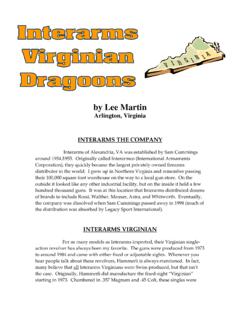Transcription of By Lee Martin - Single-Actions.com
1 By Lee MartinArlington, VirginiaThere s no other single-action that I ve used more than the Ruger Blackhawk/Vaquero. While other singles may be better fit and inherently more accurate, the Ruger offering is probably the best buy for the money. They shoot straight, are exceptionally durable, and are well suited for wildcat/custom conversions. They also have a huge secondary accessory market to include grips, backstraps, triggers, hammers, sights, With all of that in mind, I want to stress up front that I am not trying to criticize Sturm Ruger with this article.
2 Instead I d like to offer some simple advice: Please fix the .44-40 Vaquero . The problem really resides in the combination of chamber dimensions and bore diameter used on these guns. Initially it was enough of an issue that Ruger changed the .44-40 chambers on the Vaquero two years into its production. Unfortunately, there are still characteristics of the gun that make it less than acceptable. Before I get into the nuts and bolts of the situation, I d like to provide some announced its Vaquero line of single-actions around 1993; much of it was in response to the growing popularity of Cowboy Action Shooting.
3 Unlike the Italian Colt knock-offs though, the Vaquero was not a Peacekeeper clone but rather a modified Blackhawk. The grip-frame, cylinder, and extractor set-up remained unchanged from their standard single-action. What was different was the frame s top strap, finish, and barrel. Essentially, the frame is pure Blackhawk except that the top is shaved to match the profile of the Colt SAA. Secondly, the barrel is fit with a blade front sight and the exposed edge is slightly rounded. Lastly, the finishes used are either blue with a casehardened frame or high-polish stainless steel (the latter resembles nickel plating).
4 One advantage that the Vaquero has over the Blackhawk is the use of steel backstraps and ejector housings. As a result, the gun has better balance when compared to the aluminum back-strapped Blackhawks. Originally, the Vaquero was chambered for .45 Colt, .44 Magnum, and .44-40 with barrel lengths of 4 5/8 , 5 1/2 , and 7 1/2 . Since then a .357 Magnum version was added in 1997 and the birds-head Vaquero was released in early 2002. I do remember in 1993 that many gun writers had speculated that Ruger would release a.
5 38-40 and .32-20 Winchester offering in the second year of production but unfortunately that never materialized. My dad did build a .38-40 on a stainless Vaquero (much like the limited run sold through Davidson s) that s a great shooter. Hopefully this will become a standard catalogue item in time. Our first .44-40 Vaquero was bought in January of 1995 and immediately we noticed something peculiar with the , a loaded round wouldn t fit. A quick review of the chamber dimensions revealed that the throats were cut to to which is a big problem for the.
6 44-40; especially since the round uses bullets. At first we thought that the problem could be quickly remedied by opening up the throats using a Sunnen bore sizing machine. In doing so, standard .44-40s would chamber but there was another problem with using slugs. Namely, the barrel that Ruger used was the same tube as found on their .44 Magnums. Common sense would tell you that propelling a bullet down a hole can t do much for accuracy. Since the gun wasn t going to be used for anything other than plinking, we bored the throats to handle a and went to shooting.
7 Actually, the gun did pretty well but we never pushed our luck by trying it on paper. For kicking around silhouettes though it was fine. Later that year I purchased a new stainless .44-40 for a price that couldn t be passed up. Like our original, the workaround was some throat modification and bullets. When Qualite starting selling birds-head backstraps for Rugers, I immediately became interested in mating one to a stainless Vaquero. Though Ruger does offer this gun in .45 Colt, I wasn t into a barrel as short as 3 1/2.
8 With that, I settled on the 4 5/8 variety and considered either the .45 Colt or .44-40 Winchester. In spite of my previous experience with the .44-40, I decided to give it another try in the Vaquero. Much of my decision was based on the fact that Ruger supposedly fixed the problem. So in June of 2002 I bought another .44-40 Vaquero and again was surprised at what I found. Ruger did adjust the throat diameter to to but continued to use to barreling. I was kinda under the assumption that correcting the problem would entail using true.
9 44-40 barrel. Now I confess that the gun works well and for a short-tubed single-action, my birds-head shoots consistently. It still bothered me though that it wasn t correct and as result we were tempted to convert it to shoot s. Again, the throats could easily be bored to this diameter but the limiting factor turned out to be the neck chambers. Specifically, they mic d out at to which posed a problem when using lead. A quick review of our .44-40 brass showed that neck thickness ran between and for multiple makes (to include Starline, Winchester, and Remington).
10 That would mean at a minimum the chamber necks would need to be around when using the bullet. Now whereas throats can easily be altered, redoing chambers is a different story. Though it is possible to expand the neck diameter, it isn t advisable to do so without using a .44-40 chambering reamer. Secondly, when re-machining a chamber, the obvious first step is to anneal the cylinder. This not only gets into obtaining .44-40 reamers with a neck diameter of at least but also required that the cylinder be re-heat treated.




